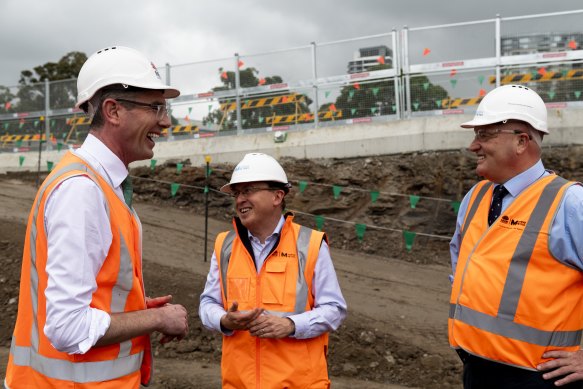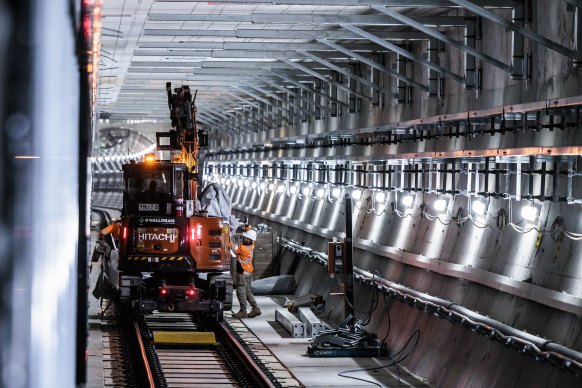This was published 2 years ago
Sydney’s metro rail project faces $200m hit due to industrial disruption
The cost to the NSW government’s flagship passenger rail project from industrial action last year has hit at least $200 million and caused headaches for contractors converting a section of existing rail track in Sydney’s south-west for driverless metro trains.
The planned opening of the main section of the City and Southwest metro line under central Sydney next year comes as the pandemic has disrupted patronage across the city’s public transport network and is expected to curb growth on the new system in its initial years.
Sydney Metro chief executive Peter Regan said the City and Southwest project had suffered at least a $200 million surge in costs from the industrial dispute between the government and rail unions last year, which prevented contractors accessing existing tracks due to refusals to switch off power.
“We’ve lost more than 22 scheduled periods of work over the last 12 months, and they are hard to catch up,” he said. “The level of disruption has been really significant.”
Regan, who has helmed the agency in charge of Australia’s largest public transport project since early 2021, said the City and Southwest line would also incur extra costs from rescheduling works, which had yet to be quantified.
Work to convert a 13-kilometre stretch of the Bankstown line to carry metro trains as part of the City and Southwest project has already been delayed by at least 12 months due to the pandemic, industrial action, and wet weather. It has pushed the opening of that section of the project into 2025.

Sydney Metro chief executive Peter Regan, centre, at a metro rail site with Premier Dominic Perrottet, left, and Transport Minister David Elliott late last year.Credit: Rhett Wyman
Regan said the agency was working on a program to reorder work on the Bankstown line in an attempt to reduce the delays but still had to determine the impact on a final opening date.
“It’s at least a 12-month delay, but we’re just trying to work out the best way to balance the level of existing service with the time needed to convert to the new service,” he said. “We can’t rush the recovery of that time because the impact on customers is too high.”
However, the main section of the new line under Sydney Harbour and the CBD from Chatswood to Sydenham remains on schedule to open next year.
“We’re really, really focused on getting the city [section] open, and we think that’ll make a massive difference because it’s a new service,” Regan said. “While the Bankstown Line is an improved service for the people on that section, they’ve already got the existing service in place.”

Workers in rail tunnels at North Sydney for Sydney’s City and Southwest metro rail line.Credit: Brook Mitchell
With patronage across Sydney’s public transport at about two-thirds of pre-pandemic levels, Regan said there was likely to be a “lag effect in terms of patronage growth” on the City and Southwest line after it opens.
“The actual patronage levels are probably going to lag for the next five years or so by two or three years behind where they might otherwise have been,” he said. “But it’s coming back, and it doesn’t change the long-run forecasts.”
Transport Minister David Elliott, who is departing state politics at the March election, said NSW was not entirely over the challenges of building new metro lines but “we’ve come a long way”, noting the breakthrough in the dispute with rail unions late last year.
“And the longer we get away from the COVID shutdowns of construction sites the better off we are at making sure we accelerate the catch-up,” he said.
Asked whether the pandemic had reduced the need for Sydney’s new metro lines, Elliott said he believed they would stand the test of time. “It is very much a case of build it, and they will come,” he said.
The Morning Edition newsletter is our guide to the day’s most important and interesting stories, analysis and insights. Sign up here.